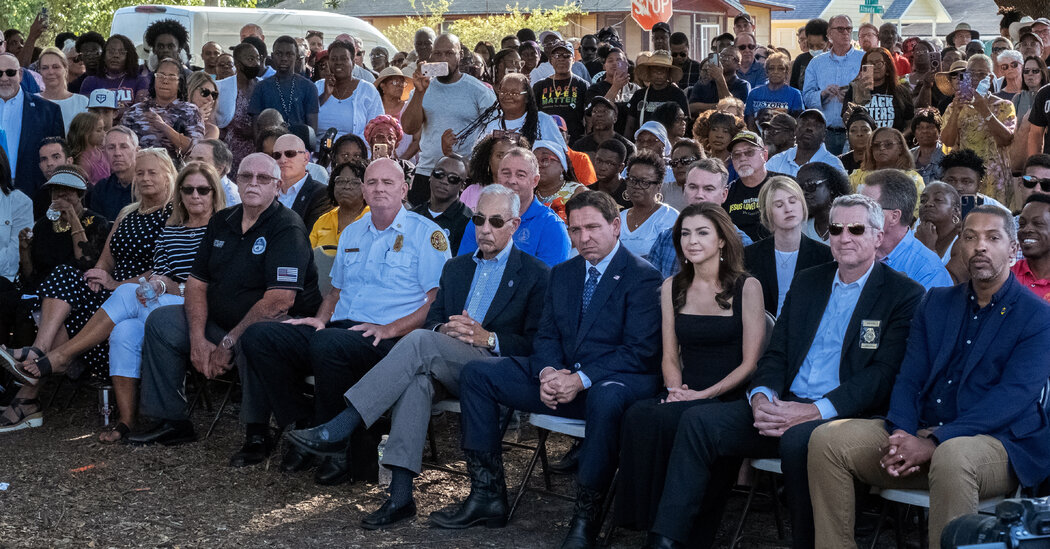What the Rain From Hilary Means for California’s Fire Risk
As most Californians know all too well, the rain that drenched the state this week was extreme and often record-breaking.
As Tropical Storm Hilary passed through California, more rain fell in San Diego and Los Angeles on Sunday than on any other August day on record. The same was true in the desert city of Palm Springs, which received about 70 percent of its annual average precipitation in a 24-hour period, according to Mark Moede, a meteorologist with the National Weather Service’s San Diego office.
“You look at those numbers, and you have to look at it twice to say, ‘Is this really real?’” Moede told me.
Hilary arrived during what is usually California’s driest time of year, and the peak of the state’s fire season. Seven of the 20 largest wildfires in California history started in August.
This raises a question: What does all the rain mean for fire risk this year?
California has had some particularly horrific fire seasons over the past decade, but 2023 has been off to a relatively calm start. Roughly 161,000 acres have burned in the state so far, compared with an average of 801,000 acres by this point in the previous five years, according to Cal Fire, the state’s fire agency. Experts have credited an extraordinarily wet winter that was followed by an unusually cool spring and early summer.
Conditions appeared to be shifting more recently, with hotter temperatures and increasingly parched vegetation as the summer wore on. A cluster of fires that broke out this month near the Oregon border has grown into the year’s biggest blaze so far.
But if you’re in Southern California, the recent rain has dampened the fire danger, at least for the next several weeks, experts say. Brush and foliage that had dried out since the spring has been replenished by the drenching, particularly in the mountainous regions most prone to wildfires.
“This has a really big fire-squashing effect,” Park Williams, a hydroclimatologist at the University of California, Los Angeles, told me. “I think this storm was big enough that the chances of really big fires in 2023 are substantially reduced in Southern California.”
The southeastern part of the state, in particular, will see that benefit. But Hilary did not do nearly as much for the Bay Area, the Central Coast or the northwest corner of the state, according to Daniel Swain, a climate scientist at U.C.L.A.
The rain that fell on Sunday in the Sierra Nevada “is one of the best kinds of weather you can get this time of year to attenuate fire season,” Swain said in an online briefing this week. “There’s likely to be a prolonged reprieve for weeks, at least, in Southern California and in places that got soaked on the eastern side of the Sierra.”
Robert Carvalho, a spokesman for Cal Fire, agreed that the storm probably diminished the fire risk in some parts of the state, but he emphasized that some danger remained. Exceptionally dry places won’t suddenly become normal, healthy landscapes because of one storm, he said. And a period of hot, dry weather in the next few months could still result in major fires later this year, he added.
“If you have a tree that hasn’t had rain in a while, just because you gave it gallons and gallons of water doesn’t mean the fuel moisture will go right back up,” Carvalho said.
Dry, fast-moving Santa Ana winds in the autumn could quickly parch vegetation again and make any fires more likely to balloon in size, Swain said.
Even so, he emphasized the break for Southern California that arrived with Hilary’s rains, particularly following so many recent severe fire seasons and at a time when much of the world has been breaking all sorts of heat, fire and flood records.
“We’re getting a bit of a reprieve this year, but unfortunately the reprieve I think is going to be more of the exception than the norm going forward,” he said. “Enjoy it while we can.”
For more:
Where we’re traveling
Today’s tip comes from Phylene Wiggins, who lives in Carpinteria. Phylene recommends visiting Paso Robles to experience the immersive light show Sensorio:
“Sensorio is an amazing outdoor work of art that covers approximately 15 acres of hills in the Paso Robles area. Using multicolored LED lights, it incorporates a variety of forms that are placed all over the hills and change colors. Arriving at dusk and letting the lights emerge as the sun goes down is ideal. There are walkways that allow people of all abilities to enjoy the show.”
Tell us about your favorite places to visit in California. Email your suggestions to [email protected]. We’ll be sharing more in upcoming editions of the newsletter.
And before you go, some good news
In February 2021, Noah Robert Warren asked Aria Aber to take a walk with him around Lake Merritt in Oakland, where they both lived.
The couple, both of whom are poets and published authors, were friends on social media but had never met in person. Though Aber didn’t initially regard their walk as a date, she immediately felt something for Warren.
A few days later, Warren asked Aber to dinner. They both told The New York Times about the protracted silence that occurred before she agreed.
“I felt like I was facing a really big decision, intuitively,” Aber, 32, said. “Like I already knew something life-changing would occur if I said yes to the dinner date.”


